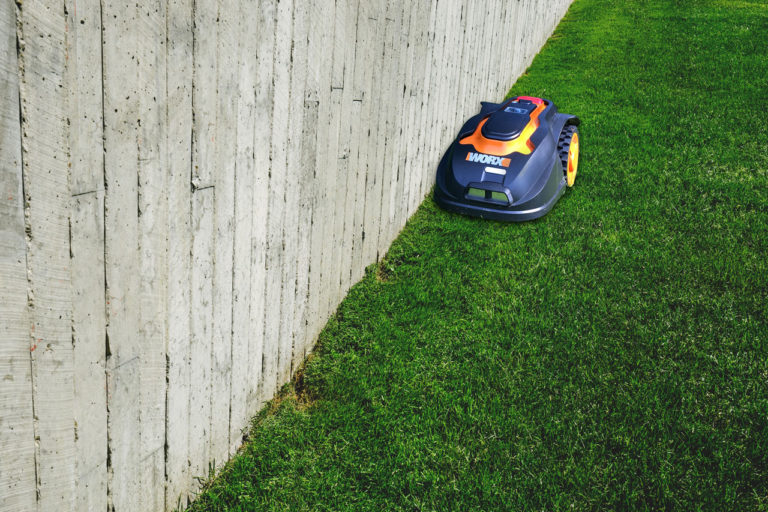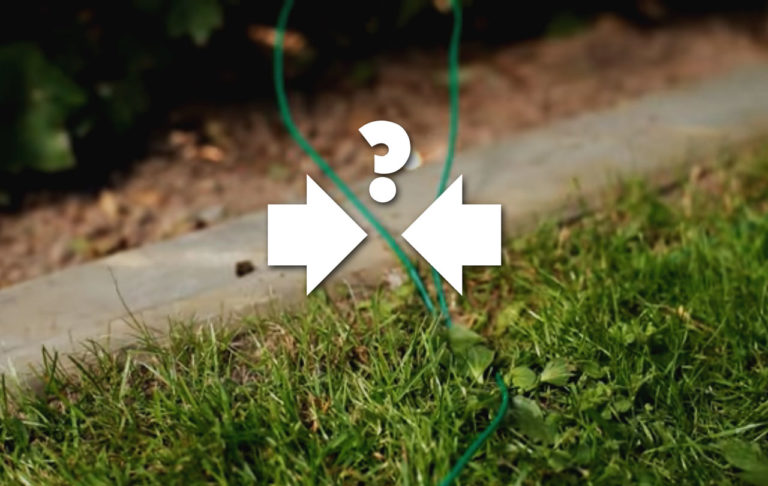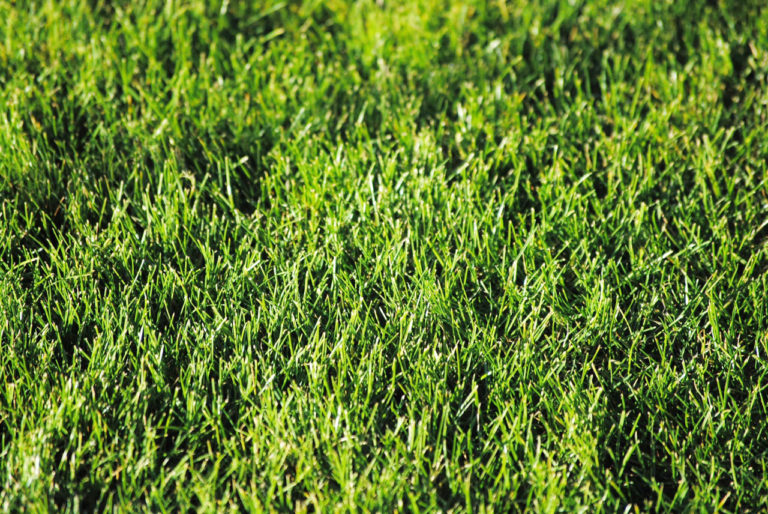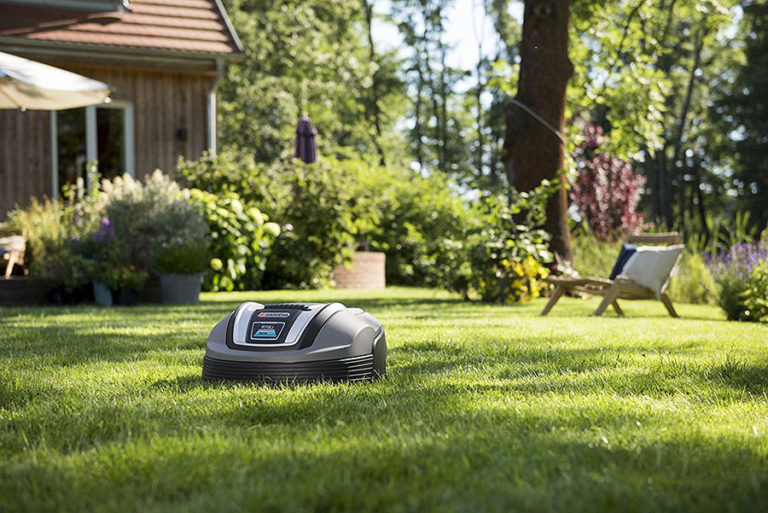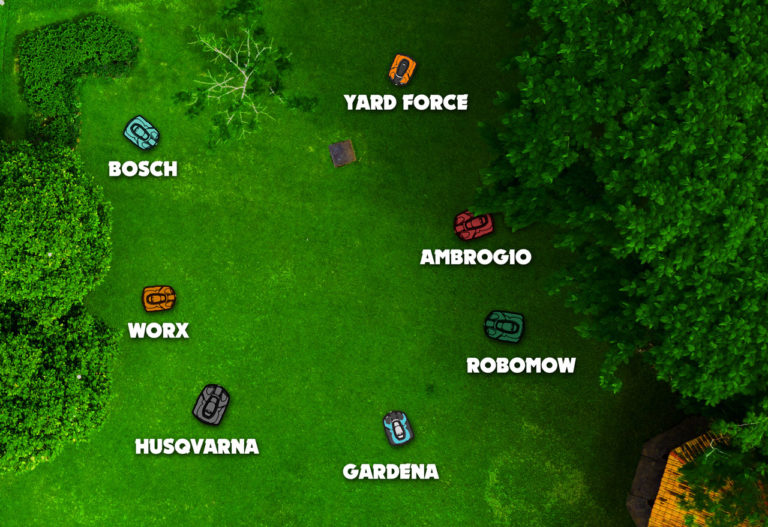You have probably heard at one point or another that mowing robots are supposed to help protect against weeds. Often the manufacturers advertise this when it is the case. I have asked myself the same question and would like to shed some light on the subject in this article. For those who don’t want to know everything in too much detail, here is the short answer to the question of whether robotic mowers really help against weeds.
Do mowing robots help against weeds? Many weeds and wild grasses cannot tolerate the frequent mowing by the robotic mower. The lawn, however, is specially adapted to these conditions. It recovers faster from mowing and grows dense and wide, which makes it generally less susceptible to weeds. In these conditions, tall weeds also find it difficult to spread and propagate, as developing buds are mowed away before they can even emerge. Mulching also improves lawn growth and reduces weeds.
However, the mowing robot is only one of many factors that can be used for weed prevention. If there are other factors encouraging the spread of weeds in your yard, the robotic mower may not necessarily help much in these cases. Some robotic mower owners even report that they have more weeds since they began using the mowing robot. This is probably in par due to the fact that once they purchase the robot, they begin to rely completely on the robotic mower for lawn care, which unfortunately is usually not enough. Fertilizing also cannot be completely replaced by grass mulching.
It can also take quite a while, sometimes several years, before you can see a noticeable difference in the amount of weeds in your lawn, as this is a really slow process. However, from the day it is first used, the robotic mower begins to make it more difficult for new weeds to settle.
Contents
How does the robotic mower robot reduce weeds?
The robotic mower reduces weeds in the lawn in various ways:
- Frequent mowing makes the lawn grow denser, while other plants have problems with frequent mowing. This makes it more difficult for alien species to colonize and spread
- Frequent mowing also prevents tall plants from developing flowers or buds to multiply and spread
- The mowing robot mulches the lawn. A regular supply of nutrients from mulching leads to a denser and healthier lawn and makes it more difficult for alien species to settle than on a weaker lawn
Plants grow where the conditions are most ideal for them. There is a perfectly adapted plant for every niche in nature. Cacti thrive in dry regions where it rarely rains, bamboo likes a warm, humid subtropical climate, lichens spread where nothing else can, and weeds? Weeds, too, have their niches in nature, where no other plant finds better conditions than they do.
Weeds are in some ways adapted to “harsher” conditions and are more likely to cope with nutrient-poor soil than, for example, the grass of your useful lawn. Soils that are unbalanced and have too much of a certain nutrient, such as nitrogen, can also attract certain varieties – in this case nettles or thistles.
The robotic mower creates conditions to which grass is best adapted to
Practical turf, on the other hand, needs a balanced, good nutrient supply. In some respects, it is more “robust” than weeds, as it copes better with being mowed regularly. This is the grass’s “niche”, so to speak: Good nutrient supply with regular pruning. Good soil aeration and sufficient water supply round off the whole thing.
The robotic mower ensures regular mowing and the regular supply of nutrients through mulching, creating that niche which provides ideal conditions for practical lawns (or display lawns, shaded lawns, etc.) and thus enables it to prevail over other plant species.
Weeds do not like to be cut back regularly
Most weeds do not like to be cut so regularly and cut so short. They also don’t benefit as much from nutrient-rich conditions as grass does, and are thus displaced by it. Also, with the frequent mowing of a robotic mower, the propagation of weeds and rogue grasses is inhibited by preventing the growth of a bud or flower they need to reproduce. This does not affect all weeds, but covers most of them.
However, if the lawn is already heavily weeded, it can take years before the “niche effect” is really visible. If you want to get rid of existing weeds, you should dig them out or remove them with weed killer. If your lawn is already doing well, the robotic mower will then make it more difficult for new weeds to grow.
A robotic mower alone is not enough to control weeds
Even if your mowing robot already contributes a lot to a better lawn appearance, you should still continue:
- Fertilization, but approx. 30 % less, as the mulch also provides nutrients
- Water regularly in dry periods
- Scarifying
- Aerifying
If you have high standards for the appearance of your lawn, the combination of a mowing robot and following these four maintenance measures is the best approach for achieving a truly weed-free lawn.
What encourages the spread of weeds?
I have already mentioned it at one point or another, but I would like to explicitly list the factors that promote weed growth here:
- Mowing too rarely
- Fertilizing too rarely or not at all
- Drying out of the lawn in summer
- Poor soil aeration
Mowing too rarely makes it easier for the weeds
Lawns can cope very well with frequent mowing, which weeds do not like. Frequent mowing strengthens the lawn and makes it grow denser and wider. This closes possible niches in which weeds could settle. Weeds can also spread more easily if you allow them to blossom and spread their seeds. Frequent mowing can at least partially stop this.
Grass needs many nutrients that weeds do better without
Weeds can survive in soils with a low nutrient content, and sometimes even prefer such soils. In nutrient-rich soils, they usually cannot compete with other plants, such as the grass of your lawn, because the other plants will grow stronger and faster and drive the weeds away.
However, if you do not fertilize the lawn often enough, the grass will not get enough nutrients and will not be able to stand up to the weeds, which have less problems with lower nutrient levels.
It is best to fertilize the lawn twice a year, once in the spring between mid-March and mid-April and once in late Summer or Autumn, between mid-August and mid-September. Since the robotic mower also fertilizes the lawn by mulching, you can use up to 30% less fertilizer.
Dried out lawns are susceptible to weeds
In summer, the lawn should be watered regularly and sufficiently. Dried out lawns become weakened and do not grow as well. Weeds that can cope better with drought can then spread over the lawn without any problems, including the annoying dandelion.
So in Summer, make sure that there is sufficient water for your lawn to not only remain nice and green, but also prevent foreign weeds from spreading in your yard.
During the Summer, you should water your lawn in the morning or evening. Preferably, you can do this in the morning, as any excess water can evaporate afterwards, which prevents mold.
Good soil aeration protects against weeds
A well-aerated soil ensures that the roots of the lawn receive more oxygen. As a result, the grass grows better and is more durable. This also protects against weeds, of course, as the stronger lawn can better fight weeds. When scarifying, which is one of the two methods you can use to aerate your lawn, weeds are removed along with moss and excess mulch.
Scarifying the lawn
When scarifying, the turf is scarified with vertical cuts to loosen up the lawn. This aerates the soil by removing excess cuttings, tangles, moss and weeds. Especially if you have carpet-like weeds, scarifying can help immensely.
It is best to scarify your yard in the Spring. There are hand-operated tools for this purpose, or petrol or electrically operated scarifiers. Unfortunately, scarifying robots do not yet exist, but if they do exist at some point, you will find out here
Aerifying the lawn
The other method of ventilation is called airing, or aerifying. This method involves punching holes out of the ground to loosen it up, and penetrates deeper into the ground than scarifying. Aerifying should also be done at regular intervals in every yard, but especially if your lawn has problems with retaining water.
Sometimes these holes are then filled with sand to prevent them from falling in again. Through the sand, air can penetrate into the deeper layers of the soil. This also improves the growth of the lawn and thus indirectly counteracts the spread of weeds.
There is no specific season for aerifying, so you can actually do it any time of the year. So-called air forks or lawn aerators are used. For very large areas there are also electrical devices. Above that, there are many more important and special things about lawn care when using a robotic lawn mower, which I covered here.
What else can you do to prevent the spread of weeds?
Once the weeds are there, you might just want to get rid of them quickly. Unfortunately, there is no other choice than to either laboriously dig everything out or use weedkillers.
#LINKS
To remove weeds by hand without using chemicals, there are weed cutters. These are available from the usual brands of gardening tools, such as GARDENA or WOLF-Garten. Other well-known brands in this area are FISKARS and TACKLIFE.
But sometimes even that does not help. The only thing left to do then is to reach for the weedkiller. There are special weed killers for lawns. Recommended here are Weedex from CELAFLOR and Banvel M from COMPO.
Related questions
Do robotic mowers cause excessive thatch buildup?
They don’t usually do this. If excessive thatch builds up on your lawn, the causes are more likely to lie elsewhere. Thatch is a collection of dead or cut grass, dead roots and other substances. Since the robotic mower mulches, meaning the cut grass remains on the lawn, it is understandable to think that this can cause thatch buildup.
Under normal circumstances, however, the grass cuttings are decomposed by the soil organisms so that they cannot accumulate. For this to happen effectively and quickly enough, however, the clippings must be fairly short. Your problem could therefore be that your robot mows too seldom and the cuttings are too long. This can then lead to thatch buildup. So make sure that your robotic mower goes out to mow at least every two days.
Even if your robotic mower does not have enough area capacity for your yard, it may end up mowing the same spot too seldom, allowing the clippings to become too long. Here you can find out what area output you actually need and how long your robotic mower needs for the area.
The decomposition process in soil can also be disturbed by other factors. For example, too low of a water permeability can lead to a sharp drop in soil activity. Scarifying and aeration also help here.
If you have problems with thatch buildup, your robotic mower is usually not the problem. You should make sure to look for other causes.
Can you do without fertilizing with a robotic mower?
The robotic mower mulches the lawn. Only the smallest topmost part of the lawn is cut off at regular intervals and distributed on the lawn. These very small clippings are quickly decomposed by soil organisms and returned to the lawn in the form of nutrients.
But does that mean you don’t have to fertilize anymore? Unfortunately, it does not. However, you can reduce the amount of fertilizer used. About 30% less nutrients need to be added externally, as they are provided to the lawn by mulching. The reason why you cannot just replace fertilizing with mulching is that the nitrogen and other nutrients released from the mulch are not sufficient for the plants. Fertilizer must be used to supply the rest.
There are special fertilizers to use with robotic mowers, which fill exactly the nutrient gaps that the mulch provided by the robotic mower cannot provide.
Do robotic mowers also help prevent moss?
Yes, robotic mowers can also help protect against moss, but it depends on what the cause of the moss is. There are factors which encourage the growth of moss that the mowing robot can influence, but others it has no influence on. The robotic mower is most effective if the moss has settled on your lawn for the following reasons:
- Nutrient deficiency
- The lawn is not cut often enough
Other causes of moss growth that even a mowing robot cannot change are:
- Strong soil compaction, in combination with waterlogging (solution: aerification)
- Too little light, too much shade (solution: shade grass)
- pH value is too low (below pH 5. Solution: Pour in suitable soil if necessary)
- Unsuitable seed mixture
No matter what the cause of moss is, scarifying and aerifying always help, at least in the meantime.
Related questions
What are the benefits of special lawn mixtures for robotic mowers? Lawn mixtures that are made as companions to robotic mowers are special lawn mixtures that are optimally adapted to the conditions that prevail when maintaining a lawn with a mowing robot. They have stronger width growth and lower length growth to reduce the risk of tangling due to clippings. They also utilize nutrients from the lawn mulch better than varieties of other lawn mixtures.
Also interesting: What are the benefits of special grass mixtures for robotic mowers?
